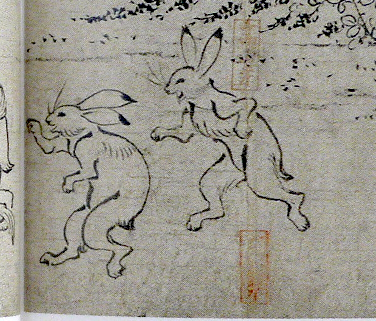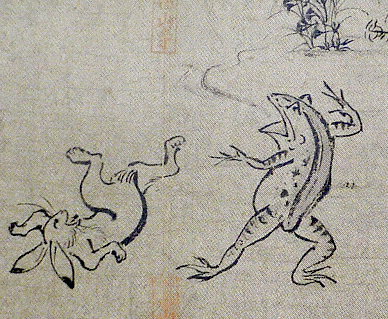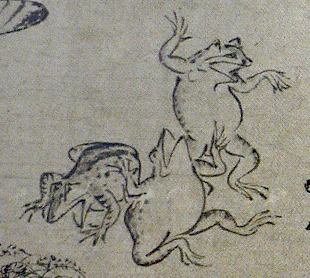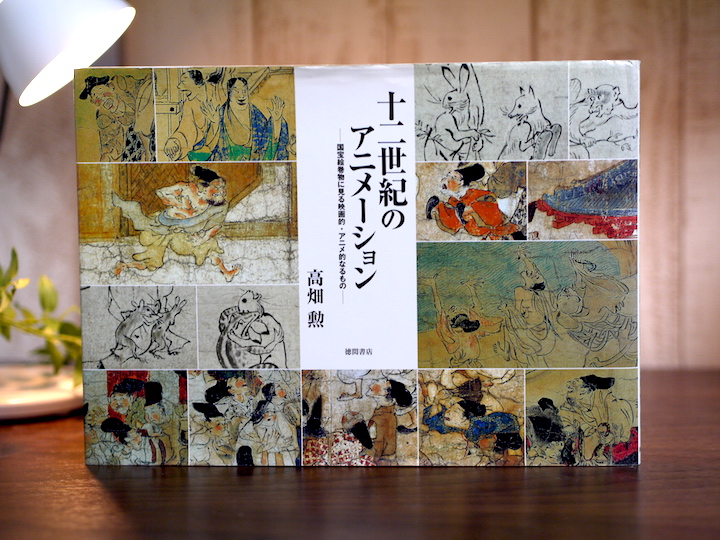アニメは850年続く日本の文化! 『十二世紀のアニメーション』〜レジェンド本を学ぶ
『鳥獣人物戯画』に見る「動き」を含んだ表現
ここまでは「絵巻物が漫画やアニメのご先祖様である」という理論の話でした。
ここからは本書に収録の絵巻物を例に、その漫画的・アニメ的表現方法を見ていきたいと思います。
ここからは本書に収録の絵巻物を例に、その漫画的・アニメ的表現方法を見ていきたいと思います。
本書では1ページ目でも触れた『信貴山縁起絵巻』での解説が中心なのですが、今回は最終章に収められている、みなさんお馴染みの『鳥獣人物戯画(ちょうじゅうじんぶつぎが)』を例にお話していきます。
ここでは、1枚絵や各キャラクター単体で見るのではなく、高畑監督の理論の通り、横にスライドして見ていくことで動きのある絵として見ていきましょう。
なお、『信貴山縁起絵巻』も、お坊さんが念力で托鉢をドローンのごとく町に飛ばし、倉を丸ごと一つ鉢で空中浮遊させて山に運ぶという、現代人もびっくりの漫画的ストーリーです。ぜひ本書にて見てみてください。
ここでは、1枚絵や各キャラクター単体で見るのではなく、高畑監督の理論の通り、横にスライドして見ていくことで動きのある絵として見ていきましょう。
なお、『信貴山縁起絵巻』も、お坊さんが念力で托鉢をドローンのごとく町に飛ばし、倉を丸ごと一つ鉢で空中浮遊させて山に運ぶという、現代人もびっくりの漫画的ストーリーです。ぜひ本書にて見てみてください。
『鳥獣人物戯画』甲巻の第17紙から18紙にかけて、絵を右から左へゆっくり見ていきましょう。
正方形か、やや上辺下辺が長めの長方形の視界(画面)が、画像の上を左に移動して映していくようなイメージで、目線を動かしてみてください。
正方形か、やや上辺下辺が長めの長方形の視界(画面)が、画像の上を左に移動して映していくようなイメージで、目線を動かしてみてください。

第17紙、第18紙(『十二世紀のアニメーション』p.132、p.133より引用)
最初に目に入るのは、二本足で立っている二羽のうさぎです。画面左に向けて何かを言っているように見えます。なんだか、テンションが高く声をかけているようです。

(『十二世紀のアニメーション』p.132より引用)
そのすぐ左では、うさぎと同サイズにディフォルメされているカエルとうさぎが取っ組み合いをしています。どうやら相撲を取っているようです。よく見ると、カエルはうさぎの両耳に食らいつき、右足をうさぎの左足にかけ、投げ技の体勢に入っています。

(『十二世紀のアニメーション』p.133より引用)
そしてまた左に視線を動かすと、少々間があったのち、カエルが何やらかっこいいポーズを決めて、口から何かを出しています。もう少し左に移動すると、投げ飛ばされてひっくり返ったうさぎが視界に入ってきます。
そう、カエルの投げが決まってうさぎを投げ飛ばしたのです。先ほどカエルの口から出ていたのは気合の一声か、勝利の雄叫びでしょうか。
そう、カエルの投げが決まってうさぎを投げ飛ばしたのです。先ほどカエルの口から出ていたのは気合の一声か、勝利の雄叫びでしょうか。

(『十二世紀のアニメーション』p.133より引用)
さらに左に進むと、カエルたちが手をひらひらさせたり、笑い転げたりしています。同じカエルさんチームの仲間が勝って喜んでいるのかもしれません。

(『十二世紀のアニメーション』p.133より引用)
このカエルとうさぎのペアは、先ほどの右側にいたペアと同じ人(?)物たちです。ここでは、画面の右から左への移動によって、時間の経過とそのペアの変化を表現しているのです。これを「異時同図」と言います。漫画であればコマ割り、アニメであればカット割りで表現するところです。
漫画でもアニメでも、続くコマやカットに同じ見た目の人物が描かれていれば、通常それは「同一人物の少し未来のシーンである」という意味になります。『鳥獣人物戯画』の手法とまったく同じですね。
もうひとつ、長めのシーンを見てみましょう。同じく甲巻の第6紙から第10紙です。
スマートフォンでこの記事をご覧の方は、画面の回転をロックして端末を横に持ち、画面の左から右へスワイプしながら見てみてください。
スマートフォンでこの記事をご覧の方は、画面の回転をロックして端末を横に持ち、画面の左から右へスワイプしながら見てみてください。

第6紙~第10紙(『十二世紀のアニメーション』p.130、p.131より引用)
最初に葉っぱでできた的(まと)のようなものと、直立のきつねとうさぎのペアが映ります。
二人は左へ振り返っているので、読者も視線を左に移動していきます。このきつねの首振りは、自然に左側に何かがあると期待させる視線誘導です。
漫画の左ページの最後のコマなどでも同じことをしますね。
二人は左へ振り返っているので、読者も視線を左に移動していきます。このきつねの首振りは、自然に左側に何かがあると期待させる視線誘導です。
漫画の左ページの最後のコマなどでも同じことをしますね。
しばらくすると、弓矢を構えたうさぎとカエルの一団がフレームインしてきます。後ろに控えのメンバーがいる辺り、どうやらうさぎさんチームとカエルさんチームに分かれての的当て対抗戦をしているようです。
そのさらに後ろには、少し高いところに立っているうさぎが、画面左の方に向かって扇を向けています。何か信号を送っているのでしょうか?
その先には、2、3人一組で荷物を運ぶうさぎとカエルの姿があります。どうやら対抗試合をしながら食べるご飯の準備をしにきたようです。うさぎとカエルが一緒になってご飯や飲み物を運んでいるのが何ともほほえましいですね。
そんな荷物運びの中、1羽だけ左奥の方を向いて「おーい」とでも呼びかけているかのようなうさぎがいます。その先には、弓矢を担いで「待ってくれー」と言わんばかりに慌てて走ってくるうさぎがいるのでした。
……いかがでしたか?
カメラの移動とキャラクターたちのしぐさや表情で、一連のシーンとして想像できたのではないでしょうか。一方「ストーリーとかメッセージとか、何が言いたいのかよく分からなかった」という方もいるかもしれません。
高畑監督は本作のストーリーについて、以下のように述べています。
というわけで、あまりストーリーやメッセージ性はなく、「カエルとうさぎが山奥でこんなことしていたら面白い」「かわいい」というだけの作品のようです。
現代で言えば、擬人化された動物たちによる日常系アニメのようなものと言えるでしょう。
現代で言えば、擬人化された動物たちによる日常系アニメのようなものと言えるでしょう。
動きだけじゃない! 絵巻物の見どころ
以上、高畑監督の理論の通り、絵巻物が漫画やアニメと同じく動きと時間の推移も表現した映像的なメディアだったことがお分かりいただけたと思います。これこそが本書の主旨です。
せっかくなので、私自身の観点からもう一点、本書の見どころをお伝えしたいと思います。おそらく今回この絵巻物を見た方が、最初にお気づきになるであろう点です。
それは、描かれているキャラクターが、現代でも通用するレベルで洗練されているということ。
それは、描かれているキャラクターが、現代でも通用するレベルで洗練されているということ。
高畑監督は漫画とアニメの描画上の特徴として「おもに輪郭線によるあまり細かい陰影をつけない平明な絵」と定義していました。
描画の点において『鳥獣人物戯画』のカエルやうさぎも、まさに輪郭線と色面(1色)で構成された平坦な絵であり、漫画やアニメと同じ描き方をされています。
描画の点において『鳥獣人物戯画』のカエルやうさぎも、まさに輪郭線と色面(1色)で構成された平坦な絵であり、漫画やアニメと同じ描き方をされています。
これは、西洋絵画が13世紀から15世紀にかけて遠近法を確立してどんどん写実的になっていき、最終的に色が厚く輪郭線のない絵画や、奥行きを完全に再現できる3DCGという表現に行きついたのと対照的です。
また、うさぎとカエルときつねを同サイズで描くという大きさのディフォルメ、直立しないはずのうさぎを直立させたりカエルに関節技をきめさせたりするなどの擬人化、カエルの雄叫びを表現する効果線など、描画の手法以外の面でも、現代の私たちにもお馴染の表現手法が数多く用いられています。
もしかしたら、現代の私たちが約850年前の表現フォーマットを未だに楽しんでいる、と考えるのが正確かもしれません。
もしかしたら、現代の私たちが約850年前の表現フォーマットを未だに楽しんでいる、と考えるのが正確かもしれません。
「絵巻物は動きや時間の経過を表現したメディアである」というのが本書のメインテーマではありますが、キャラクターの可愛さやアニメ・イラスト・漫画としての表現技法、現代に通じる文化的背景、物語の妙など、それ以外の面でも得るものの多い、学べる一冊と言えるでしょう。
漫画やアニメの表現のルーツが知りたい方、漫画やアニメにつながる日本の文化について興味がある方は、ぜひ手に取ってみてください。
『十二世紀のアニメーション』入手方法

本書は初版が1999年と古く、現在は入手が困難になっています。お探しの場合は、まずは大型書店などに問い合わせていただくといいでしょう。また、Amazonでも取り扱いがあるので、こちらを使うのもいいかもしれません。
定価3600円とやや高価な本ですので、まずは図書館などを利用するのもいいと思います。
定価3600円とやや高価な本ですので、まずは図書館などを利用するのもいいと思います。
なお、『鳥獣人物戯画』『信貴山縁起絵巻』などの巻物は、それぞれ本書以外にも出版されています。ただ、絵巻物本来の楽しみ方が再現できるよう可能な限り横長の装丁であること、かつ高畑勲監督の解説が読めるという点で、本書はかなりお買い得と言えると思います。
また、国宝級の絵巻物は、定期的に博物館などの特別展で公開されますので、本書を読んだ後は実物も観に行ってみてはいかがでしょうか。
また、国宝級の絵巻物は、定期的に博物館などの特別展で公開されますので、本書を読んだ後は実物も観に行ってみてはいかがでしょうか。
自信をもって「日本の文化だ」と言ってほしい
近年「アニメや漫画は日本の文化だ」と言われるようになりましたが、今回はそれを掘り下げる形で本書をご紹介させていただきました。
単に流行っているから・海外でも人気だから文化だ、ではなく、表現手法や描く物語の方向性というレベルで、アニメや漫画が12世紀から変わらぬ遺伝子を持っており、それが今でも変わらず楽しまれているからこそ文化と言えるのだ、ということがお分かりいただけたのではないでしょうか。
単に流行っているから・海外でも人気だから文化だ、ではなく、表現手法や描く物語の方向性というレベルで、アニメや漫画が12世紀から変わらぬ遺伝子を持っており、それが今でも変わらず楽しまれているからこそ文化と言えるのだ、ということがお分かりいただけたのではないでしょうか。
残念ながら、かつて漫画やアニメは「幼稚なもの」「子供の見るもの」とされた時代がありました。今でもなお、そういった見方をされる方もいます。
漫画やアニメを楽しむ私たちは、これこそが日本の最先端の文化の形なのだと自信を持つべきです。そういった意味でも、一度は今回ご紹介したような古典に触れ、それらを楽しんでみていただけたらと思います。
漫画やアニメを楽しむ私たちは、これこそが日本の最先端の文化の形なのだと自信を持つべきです。そういった意味でも、一度は今回ご紹介したような古典に触れ、それらを楽しんでみていただけたらと思います。

(『十二世紀のアニメーション』p.13より引用)